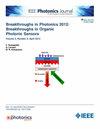Ultra-Low-Loss Silicon Photonic Waveguides Operating With the Wavelength-Bands of 1.31/1.55/2 μm
IF 2.4
4区 工程技术
Q3 ENGINEERING, ELECTRICAL & ELECTRONIC
引用次数: 0
Abstract
Silicon photonics is developing rapidly for the operation at the wavelength-bands of 1.31/1.55 μm as well as 2 μm. One of the most fundamental tasks is to develop low-loss silicon photonic waveguides, which are crucial for various photonic integrated circuits used in optical gyroscopes, tunable delay-line arrays and high-Q resonators, etc. Here silicon photonic waveguides work with ultra-low propagation losses in the wavelength-bands of not only 1.31/1.55 μm but also 2 μm are designed and demonstrated for the first time. Long waveguide spirals are designed optimally according to the comprehensive theoretical analysis, and the measured propagation losses of the fabricated waveguides are about 0.18, 0.13 and 0.07 dB/cm at the wavelength-bands of 1.31, 1.55, and 1.91 μm, respectively, which agrees well with the theoretical prediction. The total propagation loss is reduced greatly by more than a half for achieving the same time delay when using the wavelength of 1.91 μm than the wavelength of 1.31 μm.波长为1.31/1.55/2 μm的超低损耗硅光子波导
硅光子学在1.31/1.55 μm波段和2 μm波段的工作正迅速发展。低损耗硅光子波导是光学陀螺仪、可调延迟线阵列、高q谐振器等光子集成电路的关键器件之一。本文首次设计并演示了在1.31/1.55 μm波段和2 μm波段具有超低传播损耗的硅光子波导。在综合理论分析的基础上,对长波导螺旋进行了优化设计,在1.31、1.55和1.91 μm波长范围内,所制波导的传输损耗分别为0.18、0.13和0.07 dB/cm,与理论预测吻合较好。使用1.91 μm的波长比使用1.31 μm的波长在获得相同延时的情况下,总传输损耗大大降低了一半以上。
本文章由计算机程序翻译,如有差异,请以英文原文为准。
求助全文
约1分钟内获得全文
求助全文
来源期刊

IEEE Photonics Journal
ENGINEERING, ELECTRICAL & ELECTRONIC-OPTICS
CiteScore
4.50
自引率
8.30%
发文量
489
审稿时长
1.4 months
期刊介绍:
Breakthroughs in the generation of light and in its control and utilization have given rise to the field of Photonics, a rapidly expanding area of science and technology with major technological and economic impact. Photonics integrates quantum electronics and optics to accelerate progress in the generation of novel photon sources and in their utilization in emerging applications at the micro and nano scales spanning from the far-infrared/THz to the x-ray region of the electromagnetic spectrum. IEEE Photonics Journal is an online-only journal dedicated to the rapid disclosure of top-quality peer-reviewed research at the forefront of all areas of photonics. Contributions addressing issues ranging from fundamental understanding to emerging technologies and applications are within the scope of the Journal. The Journal includes topics in: Photon sources from far infrared to X-rays, Photonics materials and engineered photonic structures, Integrated optics and optoelectronic, Ultrafast, attosecond, high field and short wavelength photonics, Biophotonics, including DNA photonics, Nanophotonics, Magnetophotonics, Fundamentals of light propagation and interaction; nonlinear effects, Optical data storage, Fiber optics and optical communications devices, systems, and technologies, Micro Opto Electro Mechanical Systems (MOEMS), Microwave photonics, Optical Sensors.
 求助内容:
求助内容: 应助结果提醒方式:
应助结果提醒方式:


